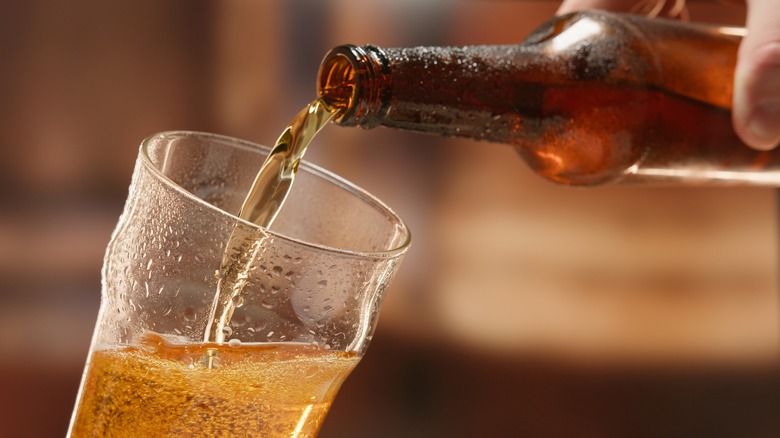How You Should Actually Store Your Beer
When it comes to most foods, air is the enemy of freshness. In fact, many foods tend to go stale quickly once they are exposed to air. Air contains water molecules, which bind with the starch molecules in food and cause them to crystallize, making the food taste hard, dry, and stale, according to Science ABC. And it turns out, beer is no exception to this rule. While alcohol might have a much longer shelf life than, say, a loaf of bread or a bag of chips, prolonged exposure to air can still cause the beer to become flat and stale over time.
Of course, if the bottle is already opened, a beer will likely become flat and unappetizing within just 24 hours, even if it is refrigerated, according to Still Tasty. But some beers can last up to three years if they remain sealed and stored correctly, according to Binwise. And while beer doesn't exactly spoil, its quality and flavor will definitely degrade over time. However, the way in which beer is stored makes a huge impact on how long its flavor and freshness will last.
Proper packaging can help beer last longer
First, it is always a good idea to store beer in the fridge. Even if you aren't planning on cracking open a cold one for a few months, the cooler temperatures can help the beer last longer. Refrigerated beer can keep for up to six months, according to Thompson Island Brewing. However, beer that is kept in a room temperature environment will likely spoil in about half the time, while beer that is stored in heat of 90 degrees Fahrenheit or higher will only last about three days, per Binwise.
Another important thing to consider is the packaging in which the beverage is stored. Beer that remains sealed in the original packaging tends to have the longest shelf life. Canned beer stays freshest the longest because the container protects the beer from sunlight. It also limits its exposure to air by limiting the amount of space between the liquid and the lid, according to the Can Can Awards. Bottled beer tends to have the next-longest shelf life. Depending on the type of bottle, it can last at least five months past its expiration date, according to Binwise. Growlers, crowlers, and kegs have a much shorter shelf life, and will likely maintain their quality over the course of only a few days.
Avoid exposure to light and air
Perhaps the most important thing to consider when storing beer is making sure to keep it away from light and air exposure. UV rays cause the beverage to oxidize and significantly degrade the taste and quality, which is why beer stored in transparent bottles tends to expire much quicker than beer kept in dark bottles. Too much air exposure can make the brew taste stale and skunky over time. Therefore, bottles should be stored upright, and never on their sides. This is because bottles on their side are exposed to much more flavor-damaging oxygen than bottles that are standing up, which only have a small amount of liquid exposed to air between the neck and the bottle cap, according to The Scotsman.
The type of beer you prefer will also affect how long it will keep without tasting off. Unfortunately for craft beer fans, microbrews and homebrews simply don't last as long as drafts and packaged beers, according to Thompson Island Brewing. Light beers like IPAs, wheat beers, or brown ales generally taste best within the first four months of bottling. Dark beers such as stouts, on the other hand, can retain their quality for up to six months. But no matter which type of brew is your favorite, following these smart storing practices will help extend the shelf life, taste, and quality of your beer.


